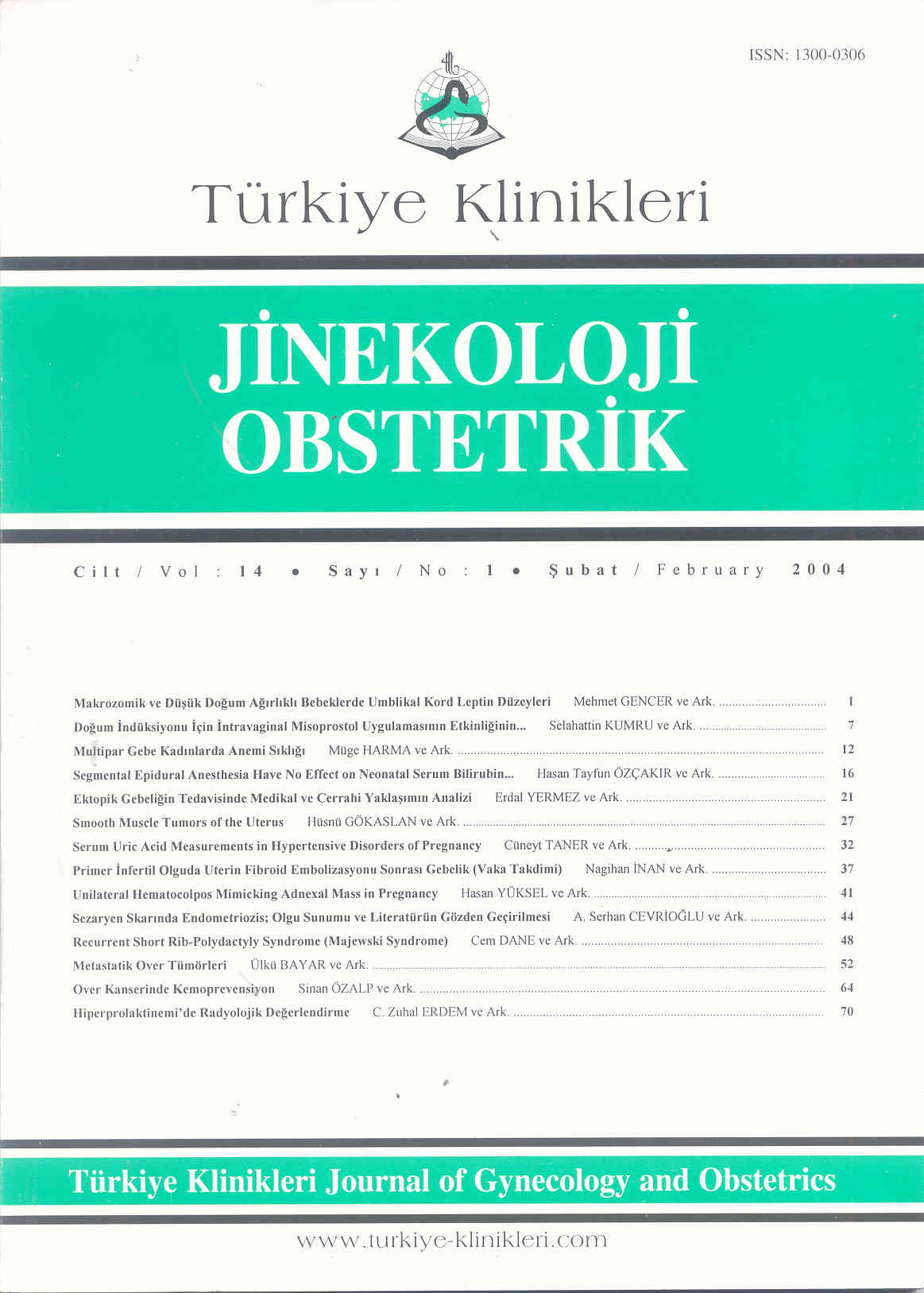Open Access
Peer Reviewed
ORIGINAL RESEARCH
3290 Viewed1251 Downloaded
Investigation Of The Efficiency And Safety Of Intravaginal Misoprostol Application For Labor Induction
Doğum İndüksiyonu İçin İntravaginal Misoprostol Uygulamasının Etkinliğinin ve Güvenilirliğinin Araştırılması
Turkiye Klinikleri J Gynecol Obst. 2004;14(1):7-11
Article Language: TR
Copyright Ⓒ 2025 by Türkiye Klinikleri. This is an open access article under the CC BY-NC-ND license (http://creativecommons.org/licenses/by-nc-nd/4.0/)
ÖZET
Amaç: Servikal olgunlaşma ve doğum indüksiyonu amacıyla intravaginal misoprostol uygulamasının etkinliğini ve güvenilirliğini araştırmak. Çalışmanın Yapıldığı Yer: Fırat Üniversitesi Fırat Tıp Merkezi Kadın Hastalıkları ve Doğum Kliniği. Yöntemler: Doğum indüksiyonuna ihtiyaç duyan ancak serviksin indüksiyon için uygun olmadığı gebelere intravaginal yoldan dört saatte bir 50 g misoprostol uygulandı. İndüksiyondan doğuma kadar geçen süre, uygulanan toplam doz, tek dozdan sonra doğuranların sayısı, sezaryene giden gebe sayısı ve sezaryen endikasyonları ile tedaviye verilen maternal ve fetal cevaplar not edildi. Bulgular: Çalışmaya otuz yedi gebe katıldı. Gebelerin %35i ilk dozdan sonra doğururken, indüksiyon başından doğuma kadar geçen ortalama süre 7.3± 3.2 saat, ortalama misoprostol dozu 86.5±30.4 g bulundu. Olguların %21.6sında takisistol gelişirken %5.4ünde fetal distres görüldü. Gebelerin yaklaşık yüzde doksanı vaginal yoldan, kalan yüzde onu da sezaryen ile doğum yaptı. Sonuçlar: Uygun olmayan serviks varlığında serviksin olgunlaştırılması ve doğumun indüklenmesi amacıyla intravaginal dört saatte bir 50 g misoprostol uygulamasının etkin ve güvenli olduğu kanaatine varıldı.
Amaç: Servikal olgunlaşma ve doğum indüksiyonu amacıyla intravaginal misoprostol uygulamasının etkinliğini ve güvenilirliğini araştırmak. Çalışmanın Yapıldığı Yer: Fırat Üniversitesi Fırat Tıp Merkezi Kadın Hastalıkları ve Doğum Kliniği. Yöntemler: Doğum indüksiyonuna ihtiyaç duyan ancak serviksin indüksiyon için uygun olmadığı gebelere intravaginal yoldan dört saatte bir 50 g misoprostol uygulandı. İndüksiyondan doğuma kadar geçen süre, uygulanan toplam doz, tek dozdan sonra doğuranların sayısı, sezaryene giden gebe sayısı ve sezaryen endikasyonları ile tedaviye verilen maternal ve fetal cevaplar not edildi. Bulgular: Çalışmaya otuz yedi gebe katıldı. Gebelerin %35i ilk dozdan sonra doğururken, indüksiyon başından doğuma kadar geçen ortalama süre 7.3± 3.2 saat, ortalama misoprostol dozu 86.5±30.4 g bulundu. Olguların %21.6sında takisistol gelişirken %5.4ünde fetal distres görüldü. Gebelerin yaklaşık yüzde doksanı vaginal yoldan, kalan yüzde onu da sezaryen ile doğum yaptı. Sonuçlar: Uygun olmayan serviks varlığında serviksin olgunlaştırılması ve doğumun indüklenmesi amacıyla intravaginal dört saatte bir 50 g misoprostol uygulamasının etkin ve güvenli olduğu kanaatine varıldı.
ANAHTAR KELİMELER: Doğum indüksiyonu, Uygun olmayan serviks, Misoprostol
ABSTRACT
Objective: To investigate the efficiency and safety of intravaginal misoprostol application for cervical ripening and labor induction. Setting: Clinics of Obstetric and Gynecology at Firat University, Firat Medical Center. Methods: Misoprostol was applicated at 50 g doses intravaginally every 4 h for cervical ripening and labor induction in cases of needing for labor induction in women with unfavorable cervix. The time passed from the induction to term, the doses used totally, delivered women after using a single dose, number of deliveries by cesarean section (C/S) together with indications of C/S and the maternal and fetal response to the therapy were recorded. Results: A total of 37 women were enrolled in the study. While 35% of pregnant women delivered after a single dose, the elapsed times after starting induction to delivery were 7.3± 3.2 hours, and misoprostol doses applied were 86.5±30.4 g. Percentages of occurrence of fetal distress and tachysystole were 5.4% and 21.6% respectively. Ninety percent of all pregnant women delivered vaginally, and the remaining pregnancies were induced by C/S. Conclusions: It is concluded that intravaginal administration of misoprostol at 50 g dose is effective and safe for cervical ripening and labor induction in cases of unfavorable cervix
Objective: To investigate the efficiency and safety of intravaginal misoprostol application for cervical ripening and labor induction. Setting: Clinics of Obstetric and Gynecology at Firat University, Firat Medical Center. Methods: Misoprostol was applicated at 50 g doses intravaginally every 4 h for cervical ripening and labor induction in cases of needing for labor induction in women with unfavorable cervix. The time passed from the induction to term, the doses used totally, delivered women after using a single dose, number of deliveries by cesarean section (C/S) together with indications of C/S and the maternal and fetal response to the therapy were recorded. Results: A total of 37 women were enrolled in the study. While 35% of pregnant women delivered after a single dose, the elapsed times after starting induction to delivery were 7.3± 3.2 hours, and misoprostol doses applied were 86.5±30.4 g. Percentages of occurrence of fetal distress and tachysystole were 5.4% and 21.6% respectively. Ninety percent of all pregnant women delivered vaginally, and the remaining pregnancies were induced by C/S. Conclusions: It is concluded that intravaginal administration of misoprostol at 50 g dose is effective and safe for cervical ripening and labor induction in cases of unfavorable cervix
MENU
POPULAR ARTICLES
MOST DOWNLOADED ARTICLES





This journal is licensed under a Creative Commons Attribution-NonCommercial-NoDerivatives 4.0 International License.










